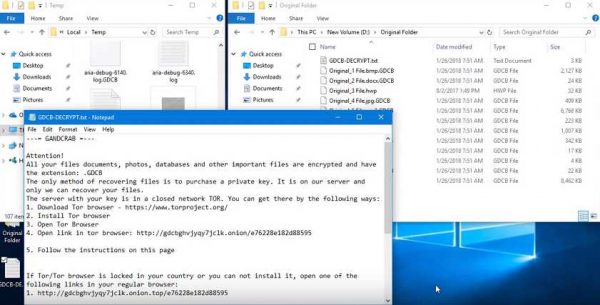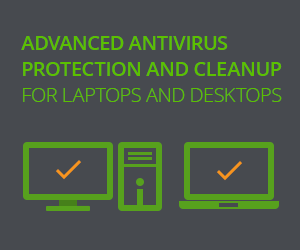Another wave of ransomware propagation circulates GandCrab virus; this release features a range of peculiarities making it a stand-alone specimen.

First off, the malware is one of a kind as it accepts payments in DASH. Most of the counterparts stick to bitcoins, with few minor exceptions, neither of which is DASH (another cryptocurrency).
Second trait worth noting is the GandCrab ransomware hosting its remote server with .BIT domain unrecognizable for common DNS. This aggravates tracing back of the scammers. On the other hand, the encryption trojan may fail to connect to the remote server. The connection to .BIT domain runs through NameCoin decentralized system (what a surprise: the decentralized currency is used for the ransom transactions). This is a peculiar if not sophisticated method, hence the connection might fail. Leaping up ahead, if that is the case the infection keeps on running its processes in the background. It basically tries to finally reach the destination, its remote hub in the NameCoin system.
Recent updates to the research on the encryptor reveal its infection vector. GandCrab typically installs into computer systems with fake bills delivered as attachments in PDF. As the user opens one, the document displays a prompt requesting to enable a macro. Opening the macro, predictably enough, discharges the malicious application into the memory. At this point, it tries to connect to the remote server and might fail due to the reasons outlined above. The follow-up to the failure is no idling; the malware repeats its attempts and may execute other processes. Needless to say, it is good to remove GandCrab encryption-for-ransom before its connecting to the remote server, and the best option is to avoid any ransomware invasion.
The remote server, if reached by the ransomware, dispatches a public key meant to scramble the data on the host device. Meanwhile, the infection also connects to ipv4bot.whatismyipaddress.com. This enables the infection to clarify the victim’s IP.
Prior to proceeding with the encryption itself, the infection scans the computer system for the processes as specified in its internal instructions. This might disable security apps, if any, installed on the compromised machine.
GandCrab applies reasonable precaution to enable the affected system survival in the basic operating mode with networking. With that purpose, it excludes relevant files types and locations from the list of encryption targets.
Apart from processing file contents, the GandCrab ransomware also adds .GDCB as an extra extension marking any encrypted item.
There is another oddity as the infection generates UAC prompt by executing the following file created in Windows directory [launched_file_name].exe.
Finally, it is time to communicate its demands to the target audience. GDCB-DECRYPT.txt is the ransom with a preliminary message. Its instances are scattered throughout the memory of the computer. A user opening one would learn that a typical scenario of ransomware invasion is unfolding. The message dropped into the memory leads to the online GUI, the latter indicating amount and terms of payment for the key that allegedly decrypts the data on a host machine. The price would amount to DASH 1.54 (circa 1000 USD).
Ransoms paid to the crooks behind ransomware contribute to their welfare and do not necessarily decrypt the data as promised. To this end, the workarounds laid down below features recovery and other ransom-free approaches to remove GandCrab ransomware for good.
Automatic removal of GandCrab Ransomware
The benefits of using the automatic security suite to get rid of this infection are obvious: it scans the entire system and detects all potential fragments of the virus, so you are a few mouse clicks away from a complete fix.
- Download and install recommended malware security suite
- Select Start Computer Scan feature and wait until the utility comes up with the scan report. Proceed by clicking on the Fix Threats button, which will trigger a thorough removal process to address all the malware issues compromising your computer and your privacy.
Restore files locked by GandCrab Ransomware
new Locky variant aka GandCrab Ransomware represents a unique category of malicious software whose attack surface reaches beyond the operating system and its components, which is why removing the virus itself is a part of the fix only. As it has been mentioned, it encrypts one’s personal information, so the next phase of the overall remediation presupposes reinstating the files that will otherwise remain inaccessible.
-
-
Launch data recovery software
Similarly to the rest of its fellow-infections, GandCrab Ransomware most likely follows an operational algorithm where it erases the original versions of the victim’s files and actually encrypts their copies. This peculiarity might make your day, because forensics-focused applications like Data Recovery Pro are capable of restoring the information that has been removed. As the virus further evolves, its modus operandi may be altered – in the meanwhile, go ahead and try this.
-
-
Take advantage of Volume Shadow Copy Service
This technique is based on using the native backup functionality that’s shipped with Windows operating system. Also referred to as Volume Snapshot Service (VSS), this feature makes regular backups of the user’s files and keeps their most recent versions as long as System Restore is on. GandCrab Ransomware hasn’t been found to affect these copies therefore the restoration vector in question is strongly recommended. The two sub-sections below highlight the automatic and manual workflow.
- a) Use Shadow ExplorerShadow Explorer is an applet that provides an easy way of retrieving previous versions of files and folders. Its pro’s include an intuitive interface where the computer’s entire file hierarchy is displayed within one window. Just pick the hard disk volume, select the object or directory to be restored, right-click on it and choose Export. Follow the app’s prompts to get the job done.

- b) Use file propertiesEssentially, what the above-mentioned Shadow Explorer tool does is it automates the process that can otherwise be performed manually via the Properties dialog for individual files. This particular approach is more cumbrous but just as effective as its software-based counterpart, so you can proceed by right-clicking on a specific file, which has been encrypted by GandCrab Ransomware, and selecting Properties in the context menu. The tab named Previous Versions is the next thing to click – it displays available versions of the file by date of the snapshot creation. Pick the latest copy and complete the retrieval by following the prompts.

-
Data backups work wonders
Ransomware like GandCrab Ransomware isn’t nearly as almighty and destructive in case you run regular file backups to the cloud or external data media. The virus itself can be completely removed in a matter of minutes, and the distorted information can then be just as easily recovered from the backup. Luckily, this is a growing trend, so ransom Trojans are hopefully going to become less subversive in the near future.
Verify thoroughness of the removal
Having carried out the instructions above, add a finishing touch to the security procedure by running an additional computer scan to check for residual malware activity
